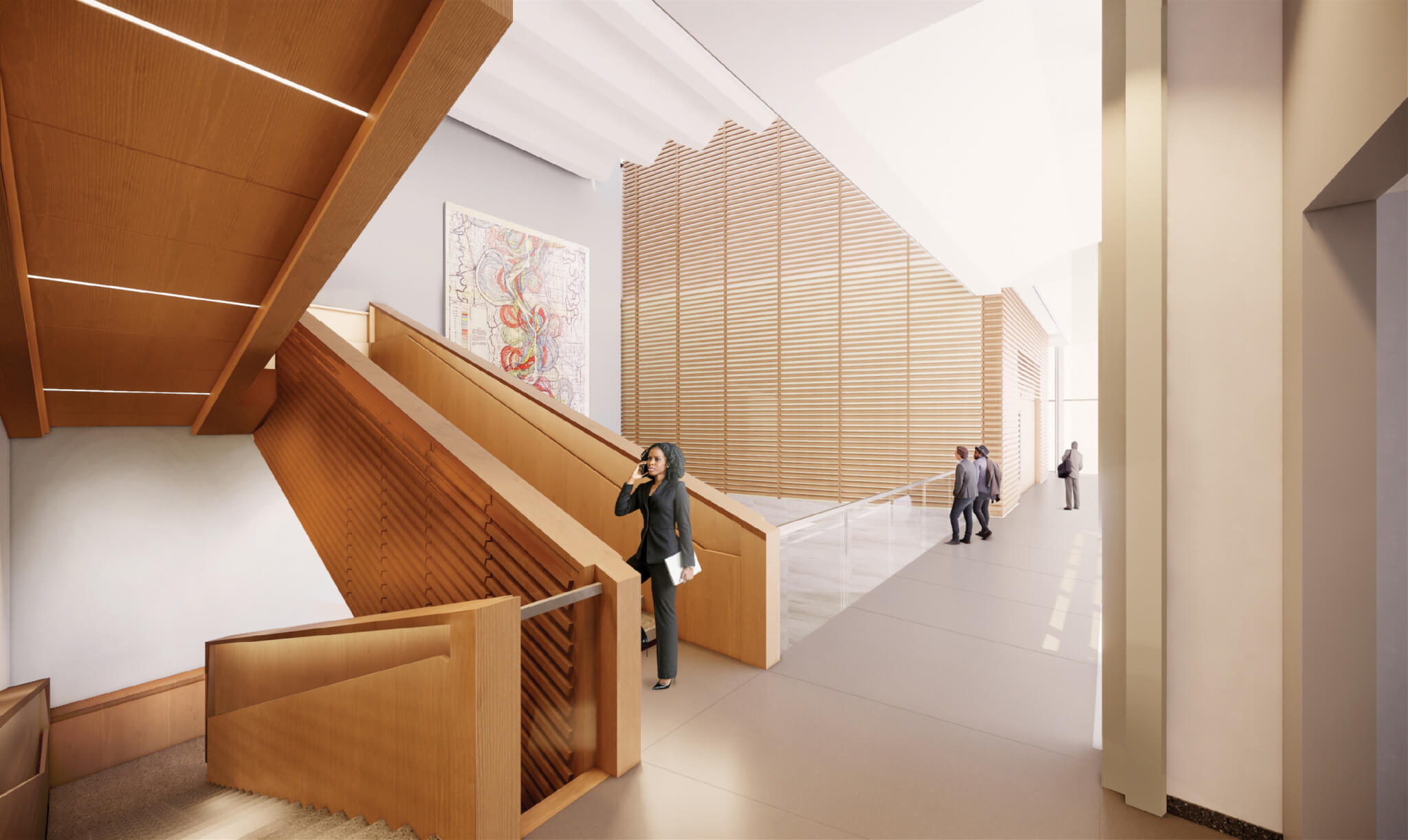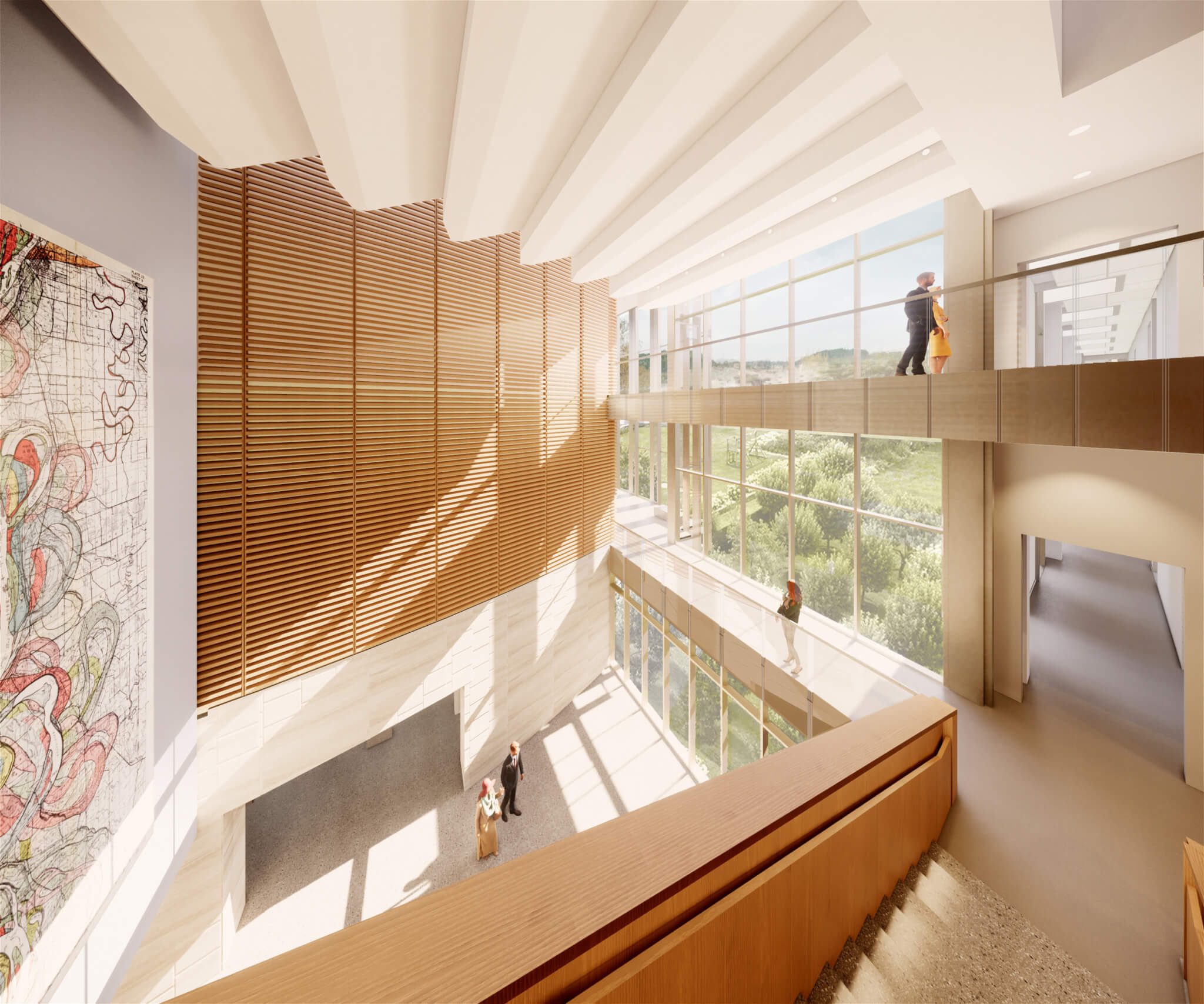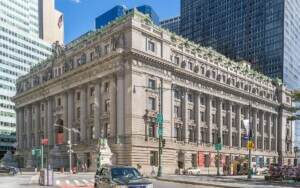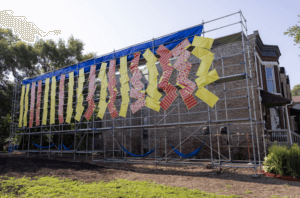A new federal courthouse broke ground today in Greenville, a small port city nestled along the shore of an oxbow lake in west-central Mississippi—a region where the circuitous course of North America’s second-longest river makes for a particularly dizzying study in state lines.
It’s the cultural and geologic landscape of the Mississippi Delta—complex and oft-calamitous—that serves as the immediate backdrop for the new $45.3 million Greenville U.S. Courthouse, which is set to rise near the municipal levee at the edge of the city’s historic downtown core on the 200 block of Washington Avenue—the same site where the original location of now-defunct discount department store chain Stein Mart opened over a century ago. Serving the needs of the Northern District of Mississippi’s Fifth Circuit, it replaces an aging 1959 federal courthouse facility co-located with the main post office on nearby Main Street.
Spanning three stories and roughly 55,600 square feet, the forthcoming facility is, first and foremost, a modern courthouse: a secure yet transparent civic landmark built to “provide visual testimony to the dignity, enterprise, vigor, and stability of the American Government,” to paraphrase the late senator, scholar, and federal courthouse eponym Daniel Patrick Moynihan. A project of the U.S. General Services Administration (GSA)’s Design Excellence Program that’s helmed by Jackson, Mississippi–based architectural practice Duvall Decker, the Greenville U.S. Courthouse is also a distinctly Southern construction with an interior illuminated by indirect “porch” light and wrapped in fluted concrete panels that shields the building from heat, humidity, and torrential rains. Outside, a park-like landscape with ample well-shaded seating will offer a leisurely place of respite to visitors and workers when the weather allows.
Adjoining a long, low-slung office block populated by various tenant agencies, the building’s two courtrooms—one district, one magistrate—are stacked, clad in wood, and “visible and veiled by a faceted glass outer skin that is alive in the ever-changing light and weather of each day,” Duvall Decker explained in a project overview. “The presence of the court becomes part of the community and opens an ongoing public conversation on the nature and workings of justice.”

“The design of the U.S. Courthouse in Greenville, Mississippi is a search for meaning and public good,” elaborated Roy Decker, who serves as cofounding principal of Duvall Decker alongside Anne Marie Duvall. “Building designs are expected to meet many requirements for functionality, safety and health, sustainability, durability, and economy. However, certain public structures that aspire to serve our society and represent our culture must do more. They must strive to be meaningful, promote inquiry, and serve as teachers to future generations. Duvall Decker is honored to lead the architectural design of the project.”
Joining Decker as co-lead designer is Steve Dumez of New Orleans–based EskewDumezRipple along with a larger team of Dewberry with Michael LaBoeuf, Engineering Resource Group, Walter P. Moore, Newcomb & Boyd, W.L. Burle Engineers, Andropogon, M.A.+ Associates, and Michael Fazio Ph.D., an architectural historian and longtime professor at Mississippi State University’s College of Architecture, Art and Design, who passed away in 2020. Alabama-headquartered Robins & Morton serves as general contractor.
Critz Campbell, a Mississippi-born artist and head of the MSU Art Department, was commissioned as part of the GSA’s Art in Architecture Program to create an artwork that will be installed on the west wall of the main lobby area.
Similar to other buildings designed and built under the auspices of the GSA, the Greenville U.S. Courthouse project has been slow-moving and spans back several years prior to its groundbreaking. In this case, the proverbial ball first got rolling in 2015 with designing work commencing at the top of 2018 and wrapping up in June 2021 per a GSA project timeline. The construction contract was awarded just this past April. “The new courthouse will both mark and define the next era in Greenville’s history and the evolution of Mississippi’s federal court presence. Its unique and functional design will generate national attention in multiple fields,” said the Honorable Debra Brown, District Judge, in a statement when the design concept was first unveiled back in 2019.

Adjacent to the 2.5-acre courthouse site there are plans for a large swath of public green space that replaces the grassy expanse of downtown Greenville’s Stein Mart Square, which is where the new courthouse will rise. The park project made local headlines in 2018 when the city sought permission from the Mississippi Department of Archives and History to raze a decrepit landmark Greek Revival building at the site that was built in 1907 as an Elks lodge.
Due in part to its location near the Greenville levee, Duvall Decker referred to the courthouse as a “lantern on the levee,” a nod to the watchmen who, during the early 20th century, would scrutinize the levees of the Mississippi Delta for breaches on dark and stormy nights by lantern light; these inspections inspired the title of the 1941 book Lanterns on the Levee by William Alexander Percy. “The illuminated watch protected the community in the same way that the judicial system protects society by maintaining the rule of law,” the firm explained.
Today, Greenville is relatively liberal and predominately Black and is known for its history of cultural diversity as numerous immigrant populations—particularly Jewish, Italian, and Chinese—settled in and around the bustling inland port city and surrounding Washington County after the Civil War; these immigrants included famed Delta retail entrepreneur Sam Stein, a Russian Jewish immigrant. As Duvall Decker elaborated, this diversity, joined by what it called the “inequities of the living circumstances of the Delta, the racial, social, and economic changes that surfaced in the 1950s and 60s,” has led U.S. Court in Greenville to “issue decisions that have helped shape the country at large,” including cases and decisions regarding civil rights, prison reform, school segregation, and on.
“The architecture of the new U.S. Courthouse in Greenville honors this history and diversity with a respectful but contemporary expression and an open, inclusive form,” added the firm.
Completion and occupancy of the Greenville U.S. Courthouse is slated for fall of 2024.











